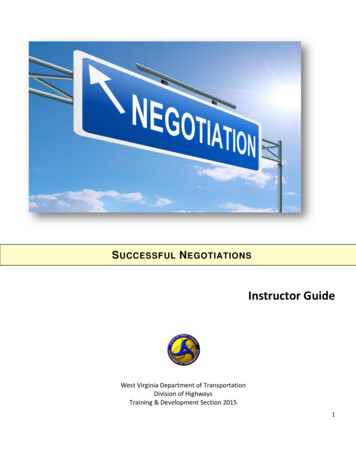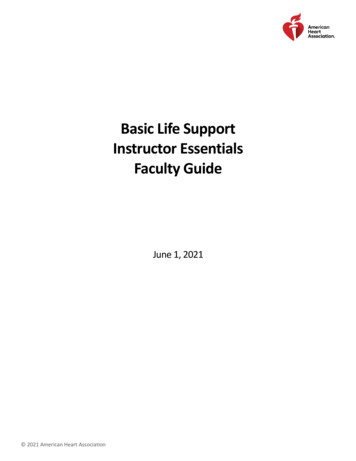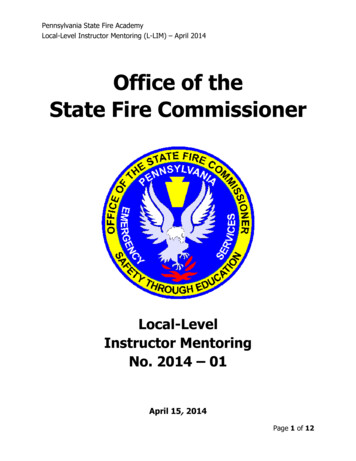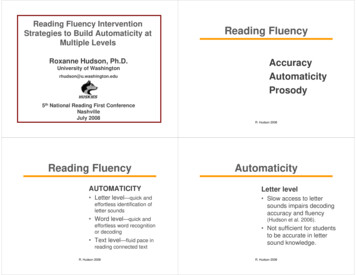
Transcription
S UCCESSFUL N EGOTIATIONSInstructor GuideWest Virginia Department of TransportationDivision of HighwaysTraining & Development Section 20151
Table of ContentsWorkshop Objectives .3Body Language in Bargaining and Negotiation (slide 3) .4Introduction (slides 1-7) .4Negotiation Styles Activity .5Three Phases of Negotiation 13Phase 1: Preparation .13Listening .13Be prepared .13Skill Set .13Best Alternatives to Negotiated Agreement 14Zones of Possible Agreement . 14Latitudes of Acceptance and Rejection 15Walk-away Price .15American Pickers video .16Create a Negotiation Bridge .16Phase 2: Bargaining .16Negotiating Techniques 16Real Estate video .17Negotiation Game: Win as Much as You Can .18Phase 3: Closing 19Common Negotiation Outcomes .19Summary of Negotiation Principles .19Final video 202
Workshop ObjectivesBy the end of this workshop you will be able to: Identify your negotiation style Identify the three phases of negotiation Identify the key skills for negotiation Establish your best alternative to a negotiated agreement Identify your zone of possible agreement Recognize your latitudes of acceptance and rejection Identify your walk-away price Create a negotiation framework Provide common negotiation outcomes3
Introduction Slide 1Although we usually think of boardrooms, lawsuits, and million-dollar deals when we hear the word “negotiation,” thetruth is that we negotiate all of the time. Did you ever decide where to eat dinner with your friends? Have you everdecided on chore assignments with your family? Did you ever ask your boss for a raise? These are all situationswhich involve negotiating. In this workshop, you will learn the phases of negotiation, tools to use during negotiation,ways to build win-win situations for all involved, and how to use a process to negotiate more effectively.FLIP CHART activityWhat do you think are the characteristics of a successful negotiator?Slide 1 Title SlideBefore starting the session take care of Step 1 on the agenda.Introduce yourself and have participants introduce themselves. Take care of housekeeping items,such as where the restrooms are located, sign-sheet, snacks and breaks. Tell them if they need totake a call or text, to please step out of the classroom. Certificates will be distributed at the end of thesession.Slide 2Have you ever If you answered yes to any of these questions, then you have participated in negotiation.Slide 3 Body Language and How to Bargain and Negotiate videoShow the video and discuss.Slide 4 To negotiate is to Review the items on the slide.Slide 5Dental Appointment videoHas your negotiation ever sounded like this?Slide 5-6ObjectivesReview these objectivesSlide 7What is your negotiation style?Let’s start the session by doing an exercise to help you identify your negotiation style.4
ACTIVITY: Negotiation Style Exercise 1NEGOTIATING STYLESELF-ASSESSMENTThe purpose of this self-assessment is to help you examine your personal negotiatingstyle.Negotiation – a process by which two parties communicate with eachother in order to reach an outcome on which they mutually agree.Directions1. Answer all questions to the best of your ability. There are no right or wrong answers. Don’t try to think of the “correct”or most “desirable” response, but simply respond with your honest reactions.2. Respond by putting a check-mark or X in one column per question or statement.How likely are you to do each of the followingwhen NEGOTIATING?1.I’ll come up with a plan so that I can steer thenegotiation to go my way.2.I’ll do things expressly to make sure that thenegotiation stays friendly and comfortable.3.I’ll go out of my way to make sure that theoutcome for the other person is fair.4.I’ll do things so that both of us can get what wewant from the negotiation.5.If something needs to be negotiated, I’llimmediately step forward to do it.6.I’ll give some in order to get some from the personI’m negotiating with.7.If the negotiation is not going my way, I’ll bail outof the negotiation.8.I’ll suggest creative solutions that allow both of usto get what we want from the negotiation.9.If it seems important for the other person to comeout on top, I’ll give in to them.VeryUnlikelyUnlikelyNeitherLikely norUnlikelyLikelyVeryLikely10. I’ll avoid difficult issues to keep the negotiationfrom getting nasty.11. If the other person compromises their position, I’llcompromise my position in return.5
How likely are you to do each of the followingwhen NEGOTIATING?VeryUnlikelyUnlikelyNeitherLikely norUnlikelyLikelyNeitherAgree orDisagreeDisagreeVeryLikely12. I’ll make sure that both of our needs areunderstood so that both of us can come out ontop.13. I’ll present information when negotiating, even if itdoesn’t necessarily always support my position.14. I’ll propose a place in the middle where we bothcan meet.15. I’ll try to see things from the other person’sviewpoint and be considerate of their needs.StronglyAgreeAgreeStronglyDisagree16. In every negotiation, both sides have to givesomething up to get something in return.17. What’s good for me is really all that matters whennegotiating.18. I’ll do almost anything to keep from having toengage in negotiation.19. In negotiating, someone wins and someone has tolose.20. The feelings of the other person that I’mnegotiating with are important to me.21. Negotiation works better when the focus is oncommon agreement rather than differences.22. I can be aggressive when it comes to getting myway from a negotiation.23. When you compromise in a negotiation, you reallyjust lose.24. If the other person gets a “raw deal” from ournegotiation, that really doesn’t matter to me.25. Keeping the comfort level high is very important tome when I’m negotiating.6
NEGOTIATING STYLESELF-ASSESSMENT – Interpretation GuideNEGOTIATING STYLE SELF-ASSESSMENT INTERPRETATION GUIDECompeting - Negotiators that exhibit this style are results-oriented, self-confident, assertive, and arefocused primarily on the bottom line, have a tendency to impose their views upon the other party, and inthe extreme can become aggressive and domineering. This style is high in Assertiveness and low inCooperativeness.Avoiding - Negotiators that exhibit this style are passive, prefer to avoid conflict, make attempts towithdraw from the situation or pass responsibility onto another party, and fail to show adequate concern ormake an honest attempt to get to a solution. This style is both low in Assertiveness and low inCooperativeness.Collaborating - Negotiators that exhibit this style use open and honest communication, focus onfinding creative solutions that mutually satisfy both parties, are open to exploring new and novel solutions,and suggest many alternatives for consideration. This style is both high in Assertiveness and high inCooperativeness.Accommodating – Negotiators that exhibit this style make attempts to maintain relationships withthe other party, smooth over conflicts, downplay differences, and are most concerned with satisfying theneeds of the other party. This style is low in Assertiveness but high in Cooperativeness.Compromising – Negotiators that exhibit this style aim to find the middle ground, often split thedifference between positions, frequently engage in give and take tradeoffs, and accept moderatesatisfaction of both parties’ needs. This style is both moderate in Assertiveness and moderate inCooperativeness.Negotiating Styles Scoring GuideI. Competing StyleIn the table below, find the numerical score that corresponds to the column that you checked for eachquestion. Enter that number to the left of the table for each question. For example, if you checkedthe “Neither Likely nor Unlikely” column for question #1, you would enter a score of 3 next to Q1.QUESTIONSCOREQ1:Q7:Q13:Very UnlikelyUnlikelyNeither Likelynor UnlikelyLikelyVery Likely1122334455Very UnlikelyUnlikelyNeither Likelynor UnlikelyLikelyVery Likely54321Strongly AgreeAgreeNeither Agreenor DisagreeDisagreeStronglyDisagree7
Q17:Q22:TOTAL:TOTAL SCORE18 OR ABOVE16 TO 1714 TO 1513 OR BELOW5544332211(Add all scores) Competing ScoreINTERPRETATIONHIGH ON COMPETING STYLE – Compared to a national sample of students, your score falls in thetop/fourth quartile (i.e., top 25%) of scores. This indicates that you strongly exhibit characteristicsconsistent with the Competing style.MODERATE TO HIGH ON COMPETING STYLE – Compared to a national sample of students, yourscore falls in the third quartile (i.e., between 50%-75%) of scores. This indicates that you moderately tostrongly exhibit characteristics consistent with the Competing style. The higher your score is, the morestrongly you exhibit characteristics consistent with the Competing style.MODERATE TO LOW ON COMPETING STYLE – Compared to a national sample of students, yourscore falls in the second quartile (i.e., between 25%-50%) of scores. This indicates that you moderatelyto weakly exhibit characteristics consistent with the Competing style. The lower your score is, the moreweakly you exhibit characteristics consistent with the Competing style.LOW ON COMPETING STYLE – Compared to a national sample of students, your score falls in thebottom/first quartile (i.e., bottom 25%) of scores. This indicates that you only weakly exhibitcharacteristics consistent with the Competing style.II. Avoiding StyleIn the table below, find the numerical score that corresponds to the column that you checked for eachquestion. Enter that number to the left of the table for each question. For example, if you checkedthe “Likely” column for question #2, you would enter a score of 4 next to Q2.QUESTIONSCOREQ2:Q10:Q5:Q18:Q25:TOTAL:Very UnlikelyUnlikelyNeither Likelynor UnlikelyLikelyVery Likely1122334455Very UnlikelyUnlikelyNeither Likelynor UnlikelyLikelyVery Likely54321Strongly AgreeAgreeNeither Agreenor DisagreeDisagreeStronglyDisagree5544332211(Add all scores) Avoiding Score.TOTAL SCORE18 OR ABOVE16 TO 1714 TO 15INTERPRETATIONHIGH ON AVOIDING STYLE – Compared to a national sample of students, your score falls in thetop/fourth quartile (i.e., top 25%) of scores. This indicates that you strongly exhibit characteristicsconsistent with the Avoiding style.MODERATE TO HIGH ON AVOIDING STYLE – Compared to a national sample of students, your scorefalls in the third quartile (i.e., between 50%-75%) of scores. This indicates that you moderately tostrongly exhibit characteristics consistent with the Avoiding style. The higher your score is, the morestrongly you exhibit characteristics consistent with the Avoiding style.MODERATE TO LOW ON AVOIDING STYLE – Compared to a national sample of students, your scorefalls in the second quartile (i.e., between 25%-50%) of scores. This indicates that you moderately toweakly exhibit characteristics consistent with the Avoiding style. The lower your score is, the more8
13 OR BELOWweakly you exhibit characteristics consistent with the Avoiding style.LOW ON AVOIDING STYLE – Compared to a national sample of students, your score falls in thebottom/first quartile (i.e., bottom 25%) of scores. This indicates that you only weakly exhibitcharacteristics consistent with the Avoiding style.III. Collaborating StyleIn the table below, find the numerical score that corresponds to the column that you checked for eachquestion. Enter that number to the left of the table for each question. For example, if you checkedthe “Unlikely” column for question #4, you would enter a score of 2 next to Q4.QUESTIONSCOREQ4:Q8:Q12:Q19:Q21:TOTAL:TOTAL SCORE21 OR ABOVE19 TO 2017 TO 1816 OR BELOWVery UnlikelyUnlikelyNeither Likelynor UnlikelyLikelyVery Likely111222333444555Strongly AgreeAgreeNeither Agreenor DisagreeDisagreeStronglyDisagree12345Strongly AgreeAgreeNeither Agreenor DisagreeDisagreeStronglyDisagree54321(Add all scores) Collaborating ScoreINTERPRETATIONHIGH ON COLLABORATING STYLE – Compared to a national sample of students, your score falls inthe top/fourth quartile (i.e., top 25%) of scores. This indicates that you strongly exhibit characteristicsconsistent with the Collaborating style.MODERATE TO HIGH ON COLLABORATING STYLE – Compared to a national sample of students,your score falls in the third quartile (i.e., between 50%-75%) of scores. This indicates that youmoderately to strongly exhibit characteristics consistent with the Collaborating style. The higher yourscore is, the more strongly you exhibit characteristics consistent with the Collaborating style.MODERATE TO LOW ON COLLABORATING STYLE – Compared to a national sample of students,your score falls in the second quartile (i.e., between 25%-50%) of scores. This indicates that youmoderately to weakly exhibit characteristics consistent with the Collaborating style. The lower yourscore is, the more weakly you exhibit characteristics consistent with the Collaborating style.LOW ON COLLABORATING STYLE – Compared to a national sample of students, your score falls inthe bottom/first quartile (i.e., bottom 25%) of scores. This indicates that you only weakly exhibitcharacteristics consistent with the Collaborating style.IV. Accommodating StyleIn the table below, find the numerical score that corresponds to the column that you checked for eachquestion. Enter that number to the left of the table for each question. For example, if you checkedthe “Very Unlikely” column for question #3, you would enter a score of 1 next to Q3.9
QUESTIONSCOREQ3:Q9:Q15:Q20:Q24:TOTAL:TOTAL SCORE19 OR ABOVE17 TO 1815 TO 1614 OR BELOWVery UnlikelyUnlikelyNeither Likelynor UnlikelyLikelyVery Likely111222333444555Strongly AgreeAgreeNeither Agreenor DisagreeDisagreeStronglyDisagree54321Strongly AgreeAgreeNeither Agreenor DisagreeDisagreeStronglyDisagree12345(Add all scores) Accommodating ScoreINTERPRETATIONHIGH ON ACCOMMODATING STYLE – Compared to a national sample of students, your score falls inthe top/fourth quartile (i.e., top 25%) of scores. This indicates that you strongly exhibit characteristicsconsistent with the Accommodating style.MODERATE TO HIGH ON ACCOMMODATING STYLE – Compared to a national sample of students,your score falls in the third quartile (i.e., between 50%-75%) of scores. This indicates that youmoderately to strongly exhibit characteristics consistent with the Accommodating style. The higher yourscore is, the more strongly you exhibit characteristics consistent with the Accommodating style.MODERATE TO LOW ON ACCOMMODATING STYLE – Compared to a national sample of students,your score falls in the second quartile (i.e., between 25%-50%) of scores. This indicates that youmoderately to weakly exhibit characteristics consistent with the Accommodating style. The lower yourscore is, the more weakly you exhibit characteristics consistent with the Accommodating style.LOW ON ACCOMMODATING STYLE – Compared to a national sample of students, your score falls inthe bottom/first quartile (i.e., bottom 25%) of scores. This indicates that you only weakly exhibitcharacteristics consistent with the Accommodating style.V. Compromising StyleIn the table below, find the numerical score that corresponds to the column that you checked for eachquestion. Enter that number to the left of the table for each question. For example, if you checkedthe “Very Likely” column for question #6, you would enter a score of 5 next to Q6.QUESTIONSCOREQ6:Q11:Q14:Q16:Q23:TOTAL:Very UnlikelyUnlikelyNeither Likelynor UnlikelyLikelyVery Likely111222333444555Strongly AgreeAgreeNeither Agreenor DisagreeDisagreeStronglyDisagree54321Strongly AgreeAgreeNeither Agreenor DisagreeDisagreeStronglyDisagree12345(Add all scores) Compromising Score10
INTERPRETATIONTOTAL SCORE20 OR ABOVE18 TO 1916 TO 1715 OR BELOWHIGH ON COMPROMISING STYLE – Compared to a national sample of students, your score falls inthe top/fourth quartile (i.e., top 25%) of scores. This indicates that you strongly exhibit characteristicsconsistent with the Compromising style.MODERATE TO HIGH ON COMPROMISING STYLE – Compared to a national sample of students,your score falls in the third quartile (i.e., between 50%-75%) of scores. This indicates that youmoderately to strongly exhibit characteristics consistent with the Compromising style. The higher yourscore is, the more strongly you exhibit characteristics consistent with the Compromising style.MODERATE TO LOW ON COMPROMISING STYLE – Compared to a national sample of students,your score falls in the second quartile (i.e., between 25%-50%) of scores. This indicates that youmoderately to weakly exhibit characteristics consistent with the Compromising style. The lower yourscore is, the more weakly you exhibit characteristics consistent with the Compromising style.LOW ON COMPROMISING STYLE – Compared to a national sample of students, your score falls in thebottom/first quartile (i.e., bottom 25%) of scores. This indicates that you only weakly exhibitcharacteristics consistent with the Compromising style.11
VI. Assertiveness and Cooperativeness IndicesNow that you know each of your negotiation style total scores, it is possible to determine your level of Assertiveness andCooperativeness. The formulas are as follows:(Your Competing Style Total Score Your Collaborating Style Total Score)(Your Avoiding Style Total Score Your Accommodating Style Total Score)Your Assertiveness IndexASSERTIVENESSINDEX5 OR ABOVE1 TO 4-2 TO 0-3 OR BELOW INTERPRETATIONHIGH ON ASSERTIVENESS – Compared to a national sample of students, your score falls in thetop/fourth quartile (i.e., top 25%) of scores. This indicates that you strongly exhibit characteristicsconsistent with Assertiveness.MODERATE TO HIGH ON ASSERTIVENESS – Compared to a national sample of students, yourscore falls in the third quartile (i.e., between 50%-75%) of scores. This indicates that you moderatelyto strongly exhibit characteristics consistent with Assertiveness. The higher your score is, the morestrongly you exhibit characteristics consistent with Assertiveness.MODERATE TO LOW ON ASSERTIVENESS – Compared to a national sample of students, yourscore falls in the second quartile (i.e., between 25%-50%) of scores. This indicates that youmoderately to weakly exhibit characteristics consistent with Assertiveness. The lower your score is,the more weakly you exhibit characteristics consistent with Assertiveness.LOW ON ASSERTIVENESS – Compared to a national sample of students, your score falls in thebottom/first quartile (i.e., bottom 25%) of scores. This indicates that you only weakly exhibitcharacteristics consistent with Assertiveness.(Your Collaborating Style Total Score Your Accommodating Style Total Score)(Your Competing Style Total Score Your Avoiding Style Total Score)Your Cooperativeness Index COOPERATIVENESSINDEX9 OR ABOVE5 TO 82 TO 41 OR BELOWINTERPRETATIONHIGH ON COOPERATIVENESS – Compared to a national sample of students, your score falls inthe top/fourth quartile (i.e., top 25%) of scores. This indicates that you strongly exhibitcharacteristics consistent with Cooperativeness.MODERATE TO HIGH ON COOPERATIVENESS – Compared to a national sample of students,your score falls in the third quartile (i.e., between 50%-75%) of scores. This indicates that youmoderately to strongly exhibit characteristics consistent with Cooperativeness. The higher yourscore is, the more strongly you exhibit characteristics consistent with Cooperativeness.MODERATE TO LOW ON COOPERATIVENESS – Compared to a national sample of students,your score falls in the second quartile (i.e., between 25%-50%) of scores. This indicates that youmoderately to weakly exhibit characteristics consistent with Cooperativeness. The lower yourscore is, the more weakly you exhibit characteristics consistent with Cooperativeness.LOW ON ASSERTIVENESS – Compared to a national sample of students, your score falls in thebottom/first quartile (i.e., bottom 25%) of scores. This indicates that you only weakly exhibitcharacteristics consistent with Cooperativeness.12
Slide 8How did you score?Go over the results from Notes Page on previous slide or on Negotiation Style Exercise: Instructor.Questions for Instructor to use in debrief:1. Once you have completed and scored the self-assessment, profile yourself (i.e. as High, Moderate toHigh, Moderate to Low, or Low) on each of the five negotiation styles. Which negotiation style or stylesis/are dominant? Is this how you seem yourself and do you agree with this assessment? Why or whynot?2. Profile yourself (i.e., High, Moderate to High, etc). with respect to Assertiveness and Cooperativeness.Do you agree with this assessment? Why or why not?3. Does your dominant negotiation style(s) match up with your Assertiveness and Cooperativeness scoreson that two-dimensional matrix? For example, if you scored in the “High” category on bothAssertiveness and Cooperativeness, your dominant style should be the Collaborating style. Does sucha match exist for you?Slide 9Three phases of negotiation Review the three phases of negotiation.Slide 10Phase 1: PreparationThis is the preparation phase. In this phase you should obtain as much information as possible about theissue to be negotiated. Try to learn more about the individual that you will be negotiating with. What is theirnegotiating style? This will help you know how to better communicate with them. Ask other businessassociates who have bargained with the individual how the negotiation went. For example, perhaps the otherparty has a reputation for always looking to rush the negotiation. You could use that to your advantage. Byremaining firm on your bargaining position, you may be able to place pressure on them to get the deal done onyour terms. If they want it to be over quickly, they will be less likely to spend time wringing concessions out ofyou. If you do not know the other party at all or know anyone else who has negotiated with them, you will haveto make educated guesses and adjust as you go.Slide 11ListeningListening will help you learn where your interests are shared with the other side, where they are in opposition,and help you obtain a satisfactory outcome. The best negotiators ask questions, test for understanding,summarize discussions and listen, listen, listen. You often get more by finding out what the other person wantsthan you do by clever arguments supporting what you need. Listen actively and acknowledge what is beingsaid. It has been said that the cheapest concession that you can make to the other side is to let them knowthat they have been heard.There is a handout on page in your packet that lists the top five tips for improving your negotiation skills.Slide 12Be prepared Be prepared to justify your offer. Research indicated that if you ask someone for a favor, he or she will bemore likely to do it if you give them a reason. The harder it is to come up with logic to support your position,13
the more you have to back into reasons that leave you feeling uncomfortable and the more concerned youshould be that the opposite party will perceive your position as overreaching.Where you start is critical to where you wind up. If you start too high, your opponent will either be ridiculous tothe other extreme, or he or she will not talk to you. If you start too low, the bullies will kick sand in your face!Slide 13Skill setThe necessity for negotiation arises because neither party will be able to get everything they want. Knowingthat there must be concessions, each party in the negotiation is required to adopt an attitude of understandingthat they must get the best deal possible in a way which is acceptable to the other party. Talk about theimportance of each of the skill sets.Self-ConfidenceSense of humorPositive attitudeRespect/TrustSlide 14Skill set (cont’d)Talk about the importance of each of the skill sets.Slide 15What is your best alternative to a negotiated agreement?In the preparation phase each party should define their:Best Alternative to Negotiated Agreement (BATNA)Zone of Possible Agreement (ZOPA)Walk Away Price (WAP)You cannot move to Phase 2 until this phase has been completed. If you try do move on without gathering allof the information about the topic to be discussed and establishing your bargaining positions, the bargainingphase cannot happen in any way that makes sense because no one knows where they stand.BATNA is the course of action that will be taken by a party if the current negotiations fail and an agreementcannot be reached. If you and the other party cannot reach an agreement what will your alternative be? WalkAway? Schedule another negotiation session later? Negotiators also need to be aware of the othernegotiator's BATNA and to identify how it compares to what they are offering.EXAMPLE: Selling a carIf the seller of a car has a written offer from a dealership to buy the seller's car for 1,000, then the seller'sBATNA when dealing with other potential purchasers would be 1,000 since the seller can get 1,000 for thecar even without reaching an agreement with an alternative purchaser.In this example, other offers that illustrate the difficulty of valuing qualitative factors might include:An offer of 900 by a close relativeAn offer of 1,100 in 45 days (what are the chances of this future commitment falling through, and would theseller's prior BATNA (the 1,000 offer from the dealership) still be available if it did?)An offer from another dealer to offset 1,500 against the price of a new car (does the seller want to buy a newcar right now, and the offered car in particular?)14
Slide 16What is your zone of possible agreement?ZOPA is a set of agreements that can satisfy both sides in a negotiation. Work to identify your counterparts'ZOPA. (HOW?)Example: To determine whether there is a positive bargaining zone each party must understand their bottomline or worst case price. For example, Paul is selling his car and refuses to sell it for less than 5,000 (his worstcase price). Sarah is interested and negotiates with Paul. If she offers him anything higher than 5,000 there isa positive bargaining zone, if she is unwilling to pay more than 4,500 there is a negative bargaining zone.Slide 17Latitudes of acceptance and rejectionFor example, if you are approached by a cancer society to make a donation to their campaign, and yourmother has cancer, then you are going to lean more towards the latitude of acceptance and make a donation.On the other hand, if you have never had anyone close to you suffer from this illness, then your level ofacceptance may fall one way or the other or somewhere in between.Slide 18Have a walk-away price(WAP) This is the price or bottom line that you are willing to accept. Keep your “Walk Away Price” to yourself.If the other party knows that you will be willing to take a lot less than you are offering, then you will benegotiating from a position of weakness. If the other party knows, or has an idea of your WAP then it stopsbeing your WAP and simply becomes your price. The other party will try to argue you down from yourproposed price, so you will need to remain firm. If they want to pay less, then you may be prepared to agreeon a lower price in return for concessions.The other party will then have to consider what is acceptable to them. Rather than push too hard and lose outon a deal which would be beneficial to themselves, they will have their own areas where they are willing tomake concessions. However, if they KNOW that you have a set WAP that would save them money, they willsimply hold firm at that price. They have no incentive to make concessions to you. In many ways, negotiationis about keeping as much to yourself as you possibly can until you can no longer maintain that position.Once you have set your WAP, it is essential to keep to it. A walk away price becomes meaningless if you arenot prepared to walk away should it not be met. You should give the impression to opponents in negotiationthat you could walk away at any time. They will not be prepared to stop once they get a price which issatisfactory to them. They will look to wring a bit more value out of the deal for themselves, testing to see what15
you will give up. You do not want to set your WAP unrealistically low or the other party will not take youseriously and consider you a pushover. They will seek to test you at every turn.Have you ever watched the show “American Pickers” on the History channel? They travel around the countrylooking through people’s garages and barns looking for antiques to buy and resell. Frank and Mike bothalways have a walk away price for what they will pay for the item but they are always fair in the price that theyoffer. If you watch the show very much, you know that sometimes they have to haggle but they are always fair.This helps them build trust with the people they are buying from. Once this trust is established and the sellersrealize that their treasure is going to be restored and displayed and that Mike and Frank are not out to justmake a buck, then they are invited to come back and “pick again” sometime. Frank and Mike will tell you intheir show that this step of negotiation is very important. Building trust. If you constantly try to low-ball, youearn that reputation and no wants to deal with you anymore.ding Your PositionSlide 19 VideoWatch the following scene in which Mike negotiates for an antique car. He realizes right away that the owneris attached to the car. He does not want to part with the car for less than 30,000 so Mike
negotiating. 18. I’ll do almost anything to keep from having to engage in negotiation. 19. In negotiating, someone wins and someone has to lose. 20. The feelings of the other person that I’m negotiating with are important to me. 21. Negotiation works better when the










